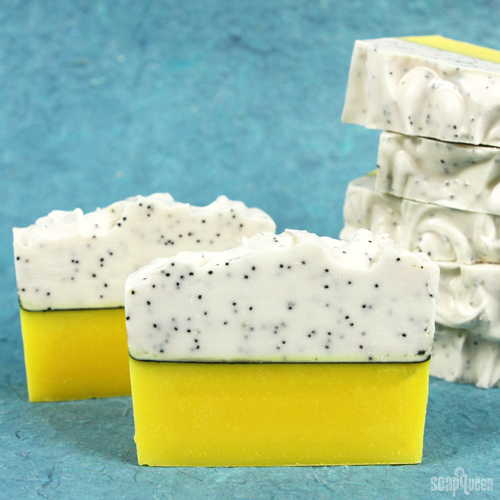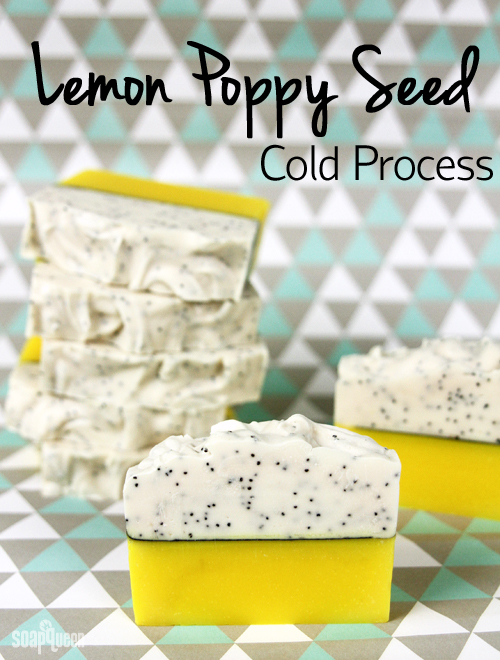
What You’ll Need:
9.9 oz. Coconut Oil
9.9 oz. Olive Oil
9.9 oz. Palm Oil
3.3 oz. Rice Bran Oil
4.6 oz. Sodium Hydroxide
10.8 oz. distilled water
1 tbs. Poppy Seeds
.5 oz. Lemon Verbena Yankee Type Fragrance Oil
1 oz. Champagne Fragrance Oil
Optional: Sodium Lactate
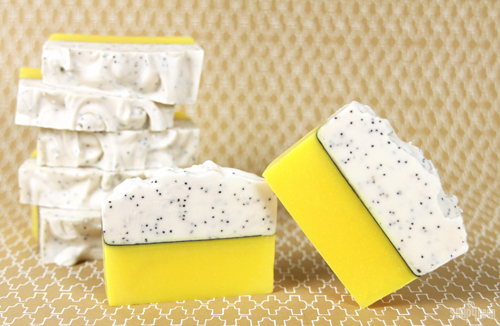
If you’ve never made Cold Process soap before, check out our FREE four part SoapQueen.tv series on Cold Process Soapmaking, especially the episode on lye safety. Bramble Berry also carries a wide range of books on the topic, including Soap Crafting. You can also checkout the digital downloads.
SAFETY FIRST: Suit up for safety! That includes goggles, gloves and long sleeves. Make sure kids, pets, and other distractions and tripping hazards are out of the house or don’t have access to your soaping space. Make sure to always soap in a well-ventilated area.

COLOR PREP: To make sure the Titanium Dioxide blends smoothly into the soap, we recommend micronizing it beforehand. This is an optional step, but it does help prevent the Titanium Dioxide from clumping. To micronize the colorant, use a coffee grinder to blend the colorant to break up any clumps of color and prevent streaks of white from showing in the final soap. When the color is micronized, mix 2 teaspoons of it into 2 tablespoons of a lightweight oil like sweet almond oil. Then mix 1 teaspoon of the Fizzy Lemonade Colorant into 1 tablespoon of oil. Use a mini mixer to incorporate.
FRAGRANCE BLEND: Mix 1 oz. of Champagne Fragrance Oil and .5 oz. of Lemon Verbena Yankee Type Fragrance Oil in a glass container and set aside for later.
ONE: Carefully and slowly add the lye to the water and stir until the lye is fully dissolved and the liquid is completely clear. Set the lye and water aside to cool.
TWO: Combine the olive, coconut, rice bran and palm oils. Remember to fully melt and mix your entire container of palm oil before adding it to the mixture. Once the oils and lye water have cooled to 130 degrees or below (and ideally within 10 degrees of each other), add the lye water to the oils. Stick blend until you reach thin trace. If you want a harder bar of soap that releases faster from the mold, add sodium lactate to your cooled lye water. Add 1 teaspoon of sodium lactate per pound of oils in the recipe. In this recipe, you will need about about 2 tsp. of sodium lactate.
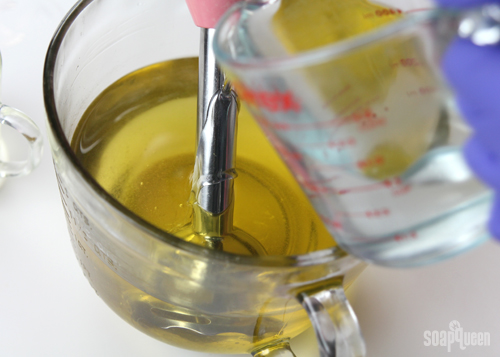
 THREE: When the soap is at light trace, pour about 3 cups of it into another container.
THREE: When the soap is at light trace, pour about 3 cups of it into another container.
 FOUR: Add 3 tsp. of the dispersed Fizzy Lemonade Colorant to the container with 3 cups of soap and mix in with a whisk.
FOUR: Add 3 tsp. of the dispersed Fizzy Lemonade Colorant to the container with 3 cups of soap and mix in with a whisk.
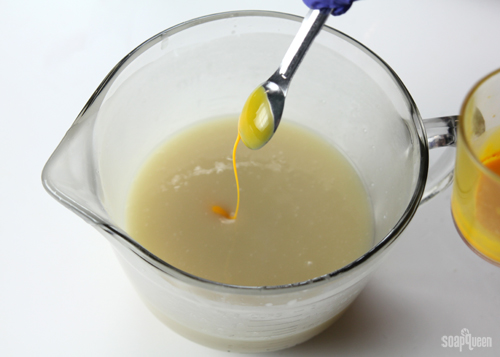 FIVE: Pour half the fragrance blend in the yellow soap and whisk to fully incorporate.
FIVE: Pour half the fragrance blend in the yellow soap and whisk to fully incorporate.
 SIX: Slowly and carefully pour the yellow soap into the silicone mold. Tap the mold on the counter to release any air bubbles and even the soap out.
SIX: Slowly and carefully pour the yellow soap into the silicone mold. Tap the mold on the counter to release any air bubbles and even the soap out.
 SEVEN: For the mica line, sprinkle a thin layer of Luster Black Mica on the yellow soap using a powder duster. To evenly disperse the line, spray lightly with 99% isopropyl alcohol. Don’t spray too much or the layers may separate.
SEVEN: For the mica line, sprinkle a thin layer of Luster Black Mica on the yellow soap using a powder duster. To evenly disperse the line, spray lightly with 99% isopropyl alcohol. Don’t spray too much or the layers may separate.

 SEVEN: In the other soap container, add 2 tbs. of the dispersed Titanium Dioxide and the rest of the fragrance oil. Mix in fully with a whisk.
SEVEN: In the other soap container, add 2 tbs. of the dispersed Titanium Dioxide and the rest of the fragrance oil. Mix in fully with a whisk.
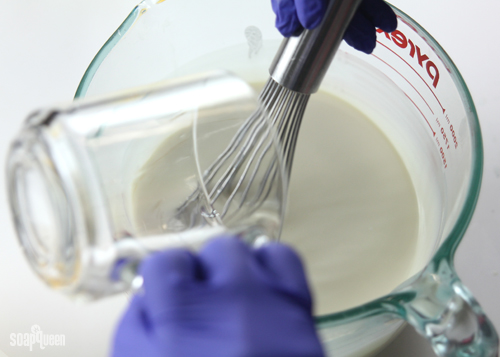 EIGHT: Pour 1 tablespoon of poppy seeds in the soap and incorporate with a whisk.
EIGHT: Pour 1 tablespoon of poppy seeds in the soap and incorporate with a whisk.
 NINE: Slowly and gently, pour the white soap into your mold. To prevent the white soap from breaking through the yellow layer, you can pour the it over a spatula into your mold. We found the yellow layer was thick enough to support the soap, so we didn’t use a spatula.
NINE: Slowly and gently, pour the white soap into your mold. To prevent the white soap from breaking through the yellow layer, you can pour the it over a spatula into your mold. We found the yellow layer was thick enough to support the soap, so we didn’t use a spatula.
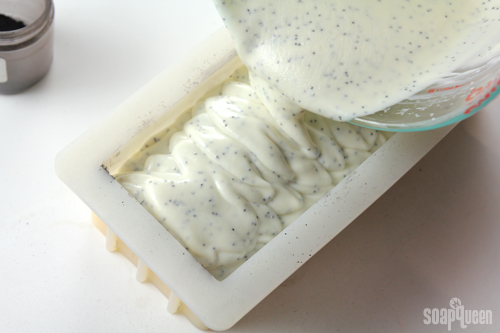 TEN: With a spatula, swirl the top of your soap to create a wave pattern. Let the soap sit in the mold for 3-4 days. Unmold it and allow to cure for 4-6 weeks. Enjoy!
TEN: With a spatula, swirl the top of your soap to create a wave pattern. Let the soap sit in the mold for 3-4 days. Unmold it and allow to cure for 4-6 weeks. Enjoy!

